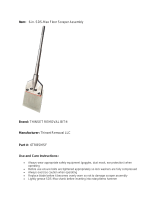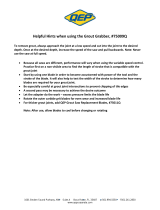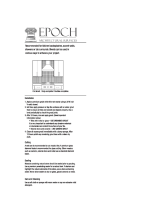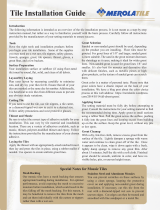
WWW.SOLISTONE.COM
INFORMATION & GUIDELINES FOR THE INSTALLATION OF STANDING PEBBLES
RECOMMENDED INSTALLATION
SOLISTONE Standing Pebbles can be used in an extensive range of design applications, indoors
and outdoors. Applications include kitchens, bathrooms, foyers, fountains, water features, pools,
pathways, feature walls, fireplaces, borders, floor accents and entertainment areas. During
manufacturing, pebbles are center-cut and hand sorted into correct sizes and individually glued
onto a mesh backing. As pebbles are a natural product, no two pieces will be exactly alike. It is
not unusual to find occasional flaws, veins and lines of separation within the pebbles. This
variation is a considered to be desired feature in the product.
NOTE: this document contains only guidelines for the installation process. A professional installer
should always be consulted to discuss the specific parameters surrounding your project.
SUBSTRATES
All substrates should be firmly fixed, flat, clean, dry and free of contaminants such as dust, oil,
paint, sealers etc. to ensure proper adhesion. Painted surfaces must be scuffed or sanded for the
product and adhesive to bond correctly. Wet areas need special attention and require
appropriate substrates, e.g. concrete, cement boards (compressed sheet), and/or treated
plywood. The use of reinforced waterproof membranes is suggested.
WATERPROOF MEMBRANES
Waterproof membranes prevent leakage of water through to the sub-floor framing and/or
habitable spaces below. Particular attention must be paid to: carrying the membrane up the wall,
outside shower boxes, installation of bond breakers, and sealing around penetrations. It is
strongly recommended that membrane systems be used in all wet areas. Some systems may
involve the use of a primer.
CURVED SURFACES
Due to its flexible mesh backing, the SOLISTONE Standing Pebble tiles can be installed around
gently curved surfaces. Some alterations of the tile may be required in order to create uniformity
by removing and replacing some of the pebbles by hand.
CUTTING
Cuts can be done with either a wet saw or a hand grinder with the appropriate blade. The mesh
backing can be easily cut with a utility knife. Some pebbles may need to be removed and
replaced by hand to make the installation look more seamless.
ADHESIVE
Follow the adhesive manufacturer’s instructions carefully. SOLISTONE does not recommend
one brand of adhesive over another. Please check with your local tile supply store for
alternative and comparable products.

WWW.SOLISTONE.COM
The manufacturer's literature will explain if the adhesive product is suitable for interiors
and/or exteriors, as well as walls and floors. Most thinset mortars (multi purpose and
polymer modified thinsets) are adequate for installing standing pebbles. A cement-based
adhesive is generally suitable on masonry substrates where no movement is anticipated.
Where slight movement could occur through thermal or pedestrian loads, a modified cement
adhesive should be used as a minimum. A 1/4” square notch trowel is recommended for most
applications. Use a gray or tinted thinset mortar if you are using the dark pebbles, and a
white thinset for lighter colors. It is very important that each pebble is embedded in the
adhesive.
GROUTING
Generally, grout is not necessary for the installation of the Standing Pebble tiles. For some
flooring applications, such as borders or floor accents where grout may become necessary, grout
should be suitable for joints up to 3/4" in width and designed for external or internal conditions
which ever may be the case. Sanded grout is generally recommended for any grout joint larger
than 1/8”. Grouts are ordinarily water mix but where some flexibility may be needed, a latex
additive or similar product should be used. It is important to wait the interval recommended by
the adhesive manufacturer before grouting to minimize dirt ingress between the pebbles and
avoid the opportunity for dislodging of the pebbles.
In the event that one desires to better expose the pebbles, it is suggested that during the grouting
process, the installer repeatedly removes the excess grout from the joints by the use of a medium
bristle brush and sponge. During this process, it is also recommended that, if necessary, the excess
grout is carved from the edge of the pebbles by use of an appropriate knife.
SEALANTS
Depending on the nature of use, sealers may or may not become necessary. We do not
recommend sealers for water features or some outside walls. However, there are various products
available on the market and we recommend contacting your nearest tile supplier for the most
appropriate sealer for your application. Whenever using sealants and acids, please ensure that
you follow the manufacturer’s recommended method of application.
CARE & CLEANING
SOLISTONE Standing Pebble mosaics must be regularly cleaned and maintained to extend the
beauty of the tile. The pebbles can be cleaned with a neutral mild detergent. The porosity or
water absorption in pebbles varies and therefore staining will occur in different degrees if the
stone is left unsealed (this may be a desired effect). Consequently, any spills should be cleaned
quickly to lessen the degree of the stain.
-
 1
1
-
 2
2
Solistone 3007.0 Installation guide
- Type
- Installation guide
Ask a question and I''ll find the answer in the document
Finding information in a document is now easier with AI
Related papers
-
Solistone 6035 User manual
-
Solistone HGRY DH-02 User manual
-
Solistone 9073 Installation guide
-
Solistone 9035 User manual
-
Solistone 9056 User manual
-
Solistone 9144f User manual
-
Solistone 2003 Installation guide
-
Solistone DURAZNO 6X6 User manual
-
Solistone 9049 User manual
-
Solistone SSH-06 Installation guide
Other documents
-
Rain Forest PTS-HNTAN User manual
-
 Cruz Bay xp3pgo User manual
Cruz Bay xp3pgo User manual
-
 Islander 20-1-BLK User guide
Islander 20-1-BLK User guide
-
Jeffrey Court 99615 Installation guide
-
 Thinset Removal Bit 6TRBSMSF User manual
Thinset Removal Bit 6TRBSMSF User manual
-
Jeffrey Court 94004 Installation guide
-
Jeffrey Court 13067 Installation guide
-
 QEP 75009Q User guide
QEP 75009Q User guide
-
 EPOCH CHIARRO SAMPLE Installation guide
EPOCH CHIARRO SAMPLE Installation guide
-
 Merola Tile WUNJOVL3 Installation guide
Merola Tile WUNJOVL3 Installation guide







